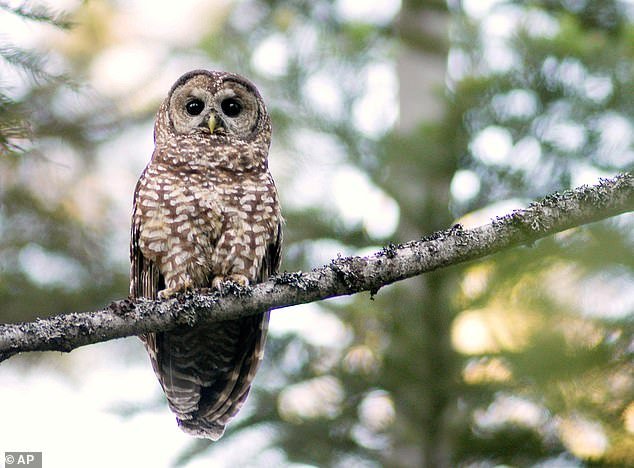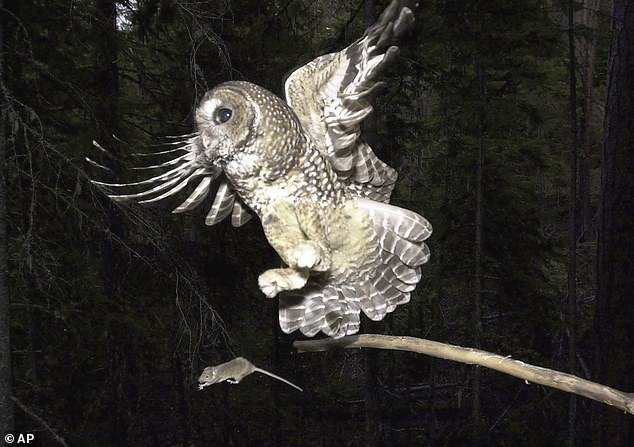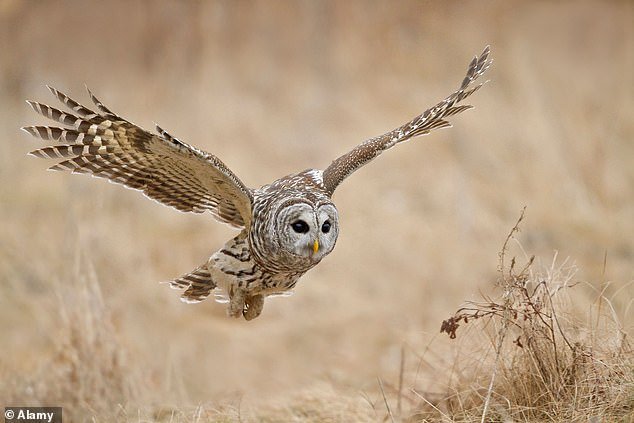The US government plans to unleash ‘hunters’ to kill half a million owls in three US states to save its endangered cousin
The lives of half a million invasive barred owls are at stake as they encroach on the California spotted owl’s endangered range.
The US Fish and Wildlife Service (FWS) plans to release ‘hunters’ in California, Oregon and Washington to kill the nocturnal birds native to the eastern US.
Under the proposal, hunters would broadcast territorial barred owl calls to attract owls and shoot them on the spot, but in areas where the use of firearms is inadvisable, the protocol would be to capture and euthanize the creature.
However, the strategy to save one species has led to outrage among 75 groups claiming their actions could disrupt nature and cause ‘murders by mistaken identity’.
The U.S. Fish and Wildlife Service has proposed killing 500,000 barred owls that invade spotted owl territory.

Spotted owls were added to the endangered species list in 1990 due to deforestation
Owls have traditionally been protected from hunters, but the FWS claimed that the barred owl has become an emerging threat to the spotted owl because they have a larger appetite, causing them to compete for the same prey.
According to the FWS, the barred owl is also known to kill the spotted owl.
The two owls look very similar, they both have round heads, brown and white colored bodies and black eyes, and are distinguished only by their slight difference in size and the color of their beaks.
Spotted owls are about 1.5 meters long and have a wingspan of up to 1.20 meters, while barred owls are larger and about 60 cm long with a wingspan of up to 1.20 meters.
Barred owls began migrating from their native range in the northeastern U.S. into the forests of Washington, Oregon and Northern California in the early 1900s due to climate change and deforestation.
In 1990, the spotted owl was added to the Endangered Species Act due to habitat loss, but now the barred owl’s migration over the past century is believed to have worsened the situation.
Organizations led by Animal Wellness Action and the Center for a Humane Economy wrote a letter Monday against Interior Secretary Deborah Haaland, accusing her of a “reckless” plan to shoot 500,000 barred owls over the next 30 years.

The spotted owl is further endangered because the barred owl eats much of its food source

The FWS previously culled more than 2,000 barred owls, but research showed this did not make a major difference to the spotted owl population.
Climate change has contributed to animal adoption behavior and migration patterns, the letter said, adding: “We cannot victimize animals because they adapt to human disturbances of the environment.”
The problems first arose in the late 1980s and 1990s, when environmentalists fought against loggers trying to harvest timber in the northwest forests – the conflict became known as the Timber Wars.
During this time, the spotted owl, which lived in the old trees, began to dwindle, leading to protection of the bird and its habitat.
Despite this, the FWS released its 264-page proposal in November, stating that culling the barred owls was essential to protect the endangered spotted owl.
However, when asked why so many barred owls need to be culled and how many spotted owls they have killed, an FWS spokesperson referred Dailymail.com to a press release that said, “Barred owls have not had a substantial impact on California spotted owl populations to date.”
Instead, the publication stated that the purpose of culling so many owls is to eliminate their future expansion and range and reduce any populations that might become established in future years.
“Competition from the invasive barred owl is a primary cause of the rapid and continued decline of northern spotted owl populations,” the release said.
“Because of the rate of decline, it is critical that we manage invasive barred owl populations to reduce their negative impact before northern spotted owls are extirpated from large parts of their native range,” it added.
The FWS is currently reviewing public input and is expected to make a final decision in late spring or early summer.
If approved, the FWS will receive a Migratory Bird Treaty Act permit that allows the hunting and killing of barred owls.
The FWS initiated a five-year experiment to cull 2,485 barred owls from spotted owl areas in the Pacific Northwest when the invasive birds first appeared.
The experiment was not entirely successful, according to the letter to Haaland, which stated that the Results showed only a short-term reduction in owl numbers and “modest numerical gains for spotted owls.”
“The disturbance caused by the shooting alone would adversely affect a wide range of species, together with the direct, incidental killing that would inevitably result,” the letter said, adding: “The nighttime hunting the animals is unimaginable and even more impractical. .’
“This is a case in which the federal nature conservation organization can no longer see the forest for the trees.”
